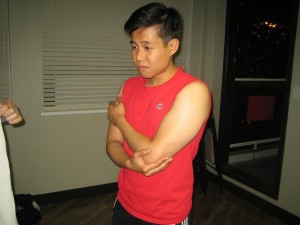Arm and elbow pains are caused by the overuse of the arm, especially those who play tennis and golf. Tendons in the elbow become inflamed and start to ache, and it is a sign of tendonitis. Anyone experiencing pain in the elbow and arms should stop any physical activities and rest.
People experiencing pain on the outside or thumb side of the arm and elbow are suffering from lateral epicondylitis or also known as tennis elbow. This injury happens when tendons in the forearm and arm rubs against the lateral epicondyle bone during any type of physical activity.
Those people with pains on the inside or the little finger side of the elbow are suffering from medial epicondylitis or also known as golfer’s elbow. The injury happens when the tendons rub against the medial epicondyle bone.
Olecranon bursitis can happen when the tip of the elbow starts to swell and reddens. It is triggered by damage, strain or certain health conditions like rheumatoid arthritis or gout. An individual can also experience broken bones, entrapment of the ulnar nerve and an injured ligament in the elbow.
A dislocation of the elbow happens when there is lot of stress on the elbow, like an accident, a fall or getting hit in a sport like football.
An elbow is bent backwards farther than its normal range of motion, thus hyperextension of the elbow can happen. It causes damage to the ligaments and tissues in the elbow and can cause pain.

First aid treatment of arms and elbow pains
- Remove all jewelries like rings, bracelets, watches that go around your wrist or fingers of the injured arm. It would be difficult to remove the jewelries when swelling has already developed.
- Using (RICE) rest, ice, compression and elevation to treat the pain and swelling.
- The injured person has to wear a sling for the first 48 hours after the injury. This can make the injured person comfortable and will support the injured area.
- The caregiver should provide an elbow support like an elbow sleeve, a forearm wrap or arm sling to help rest the elbow joint. This will also relieve the stress on the forearm muscle and for protection of the joint during the activity. A counterforce brace can be used to help with tennis elbow symptoms.
- Massage and rub the area gently to relieve pain and encourage blood flow. Do not massage if it causes pain.
- After an injury, the individual must avoid activities that might increase swelling, like hot showers, hot tubs, hot packs or drinking alcoholic beverages.
- After 48 to 72 hours, if there is no more swelling, apply heat and exercise with the aid of moist heat to restore flexibility.
- If ice packs do not reduce the swelling in the elbow, discuss about the hydrocortisone gel treatment with a physical therapist. Take a course on first aid training so that you will learn the effectiveness of ice on certain injuries.
- After 24-48 hours, encourage the individual to move the affected area. If it still causes pain, give the area more time to rest. Performing mild stretching will prevent scar tissue formation which decreases movement.